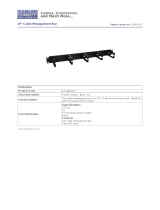
17 Order supplies and accessories ....................................................................................................................................................... 291
Order ink supplies ................................................................................................................................................................ 291
Order accessories ................................................................................................................................................................ 292
18 Printer specications ......................................................................................................................................................................... 293
Functional specications .................................................................................................................................................... 294
Physical specications ........................................................................................................................................................ 294
Memory specications ........................................................................................................................................................ 294
Power specications ............................................................................................................................................................ 294
Air supply requirements (pneumatic spindle) ................................................................................................................. 295
Ecological specications ..................................................................................................................................................... 295
Environmental specications ............................................................................................................................................. 295
Ventilation ............................................................................................................................................................................. 296
Air conditioning .................................................................................................................................................................... 297
Acoustic specications ........................................................................................................................................................ 297
Appendix A Rigid substrate recommendations .................................................................................................................................. 298
Recommended print modes (introduction) ..................................................................................................................... 299
Use Sensitive Mode with heat-sensitive substrates ....................................................................................................... 299
Predened substrate settings ........................................................................................................................................... 300
Acrylic sheet (PMMA) ........................................................................................................................................................... 301
Aluminum composite panel (ACP) ..................................................................................................................................... 303
Compressed cardboard or cardstock ................................................................................................................................ 305
Corrugated cardboard ......................................................................................................................................................... 306
Corrugated plastic ................................................................................................................................................................ 307
Foam board ........................................................................................................................................................................... 309
Foam PVC .............................................................................................................................................................................. 310
Glass and ceramics .............................................................................................................................................................. 312
Wood ...................................................................................................................................................................................... 313
Polycarbonate sheet ........................................................................................................................................................... 314
Polystyrene sheet ................................................................................................................................................................ 315
Polypropylene sheet ........................................................................................................................................................... 316
PVC rigid sheet (U-PVC) ...................................................................................................................................................... 317
PET (A-PET, PET-G) rigid sheet .......................................................................................................................................... 318
PE (LDPE, HDPE) rigid sheet ............................................................................................................................................... 319
Honeycomb panels .............................................................................................................................................................. 320
Metal panels ......................................................................................................................................................................... 321
Appendix B Flexible substrate recommendations ............................................................................................................................. 322
Predened substrate settings ........................................................................................................................................... 323
Self-adhesive vinyls ............................................................................................................................................................. 324
PVC banners ......................................................................................................................................................................... 325
Papers .................................................................................................................................................................................... 326
vi ENWW





















